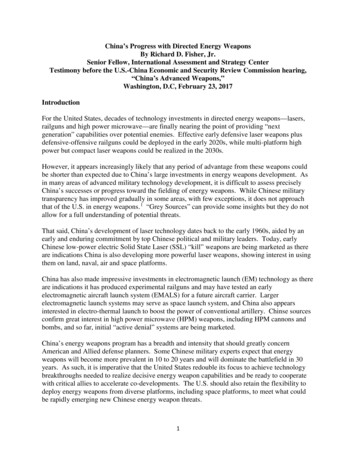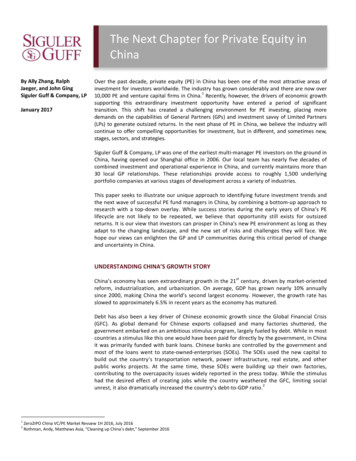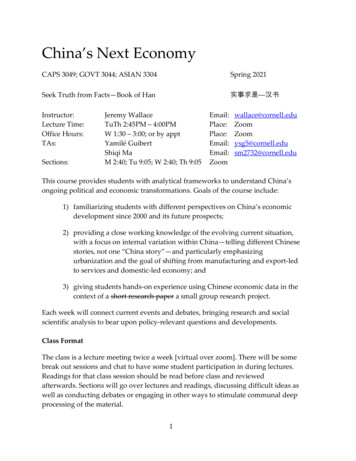
Transcription
China’s Progress with Directed Energy WeaponsBy Richard D. Fisher, Jr.Senior Fellow, International Assessment and Strategy CenterTestimony before the U.S.-China Economic and Security Review Commission hearing,“China’s Advanced Weapons,”Washington, D.C, February 23, 2017IntroductionFor the United States, decades of technology investments in directed energy weapons—lasers,railguns and high power microwave—are finally nearing the point of providing “nextgeneration” capabilities over potential enemies. Effective early defensive laser weapons plusdefensive-offensive railguns could be deployed in the early 2020s, while multi-platform highpower but compact laser weapons could be realized in the 2030s.However, it appears increasingly likely that any period of advantage from these weapons couldbe shorter than expected due to China’s large investments in energy weapons development. Asin many areas of advanced military technology development, it is difficult to assess preciselyChina’s successes or progress toward the fielding of energy weapons. While Chinese militarytransparency has improved gradually in some areas, with few exceptions, it does not approachthat of the U.S. in energy weapons. 1 “Grey Sources” can provide some insights but they do notallow for a full understanding of potential threats.That said, China’s development of laser technology dates back to the early 1960s, aided by anearly and enduring commitment by top Chinese political and military leaders. Today, earlyChinese low-power electric Solid State Laser (SSL) “kill” weapons are being marketed as thereare indications China is also developing more powerful laser weapons, showing interest in usingthem on land, naval, air and space platforms.China has also made impressive investments in electromagnetic launch (EM) technology as thereare indications it has produced experimental railguns and may have tested an earlyelectromagnetic aircraft launch system (EMALS) for a future aircraft carrier. Largerelectromagnetic launch systems may serve as space launch system, and China also appearsinterested in electro-thermal launch to boost the power of conventional artillery. Chinse sourcesconfirm great interest in high power microwave (HPM) weapons, including HPM cannons andbombs, and so far, initial “active denial” systems are being marketed.China’s energy weapons program has a breadth and intensity that should greatly concernAmerican and Allied defense planners. Some Chinese military experts expect that energyweapons will become more prevalent in 10 to 20 years and will dominate the battlefield in 30years. As such, it is imperative that the United States redouble its focus to achieve technologybreakthroughs needed to realize decisive energy weapon capabilities and be ready to cooperatewith critical allies to accelerate co-developments. The U.S. should also retain the flexibility todeploy energy weapons from diverse platforms, including space platforms, to meet what couldbe rapidly emerging new Chinese energy weapon threats.1
For the U.S., the Promise of Directed Energy Weapons Gets CloserA matter of great interest in the U.S. Department of Defense since the late 1960s, energyweapons have long been viewed as “the weapons of the future, and always will be.” However,the last decade has seen greater Department of Defense support for directed energy weapons, asthis technology improves, including increases in power and size reduction of Solid State Lasers,and the advance of electromagnetic launch technology. These, along with a scaling back ofcapability ambitions, may result in the nearterm emergence by early in the next decade of usefulAmerican energy weapons.Electric powered Solid State Lasers (SSL), railguns, and microwave weapons offer potentialadvantages in numbers of “rounds” and cost per rounds over missiles and other kinetic weapons,potentially transforming future battlefields. A U.S. Raytheon Standard SM-3 Block 1B missileinterceptor may cost about 14 million, 2 versus a 7 million Chinese anti-ship ballistic missile(ASBM), while a railgun hypersonic velocity projectile may only cost 50K. Energy weaponshave the potential for ending the advantage that China and North Korea gain from large numbersof tactical and theater- range missiles, while offering new defensive and offensive capabilities forland, naval, air and space platforms.Nearterm transformation by the early to mid-2020s could come from the ElectromagneticLaunch Gun (EMLG) or railgun. 3 The system currently under development for the U.S. Navy byBritish Aerospace Systems (BAE) and Boeing, may fire a shot at hypersonic Mach 7 speed,suitable for intercepting maneuvering missiles with “shotgun” pellets, or attacking targets at 200nautical miles (370km). Deployment on nuclear powered aircraft carriers or “electric” poweredships like the USS Zumwalt could allow defeat of China’s much-vaunted ASBM. GeneralAtomics is marketing its smaller 100km range “Blitzer” railgun, now in advanced development,for naval and land platforms. 4In the 1970s and 1980s, U.S. scientists examined the development of missile defense satellitesusing nuclear-pumped Free Electron X-Ray and chemical powered lasers to defeat Soviet nuclearICBMs, an ambition that became part of Ronald Reagan’s March 1983 Strategic DefenseInitiative. 5 While a U.S. laser-satellite missile defense network was never realized, 6 one result ofthis effort was the Boeing YAL-1 airborne megawatt (millions of watts) class Chemical OxygenIodine Laser (COIL). Intended as a battlefield missile defender, it was an impressiveachievement that aided large military laser development and did shoot down missiles. But basedon a large Boeing 747 platform, only one was built and retired in 2011, 7 due to its high cost,volatile chemical fuel, low 20 “round” magazine, and limited laser range making the largeplatform tactically vulnerable.Chemical lasers, however, are being eclipsed by increasingly powerful electric powered SSLs,with greater potential for size reduction and with a “magazine” theoretically limited by availablepower. Defensive SSLs could see deployment by the early 2020s. In late 2014 the U.S. Navydeclared as an operational weapon its Kratos Defense and Security Solutions AN/SEQ-3 (XN-1)Laser Weapon System (LaWS), a 30 kilowatt (thousands of watts) laser capable of defeatingswarming drones and small ships at close range. The Navy could test a 150 kilowatt class laserby 2018 and deploy it by 2020. 8 Boeing and Northrop-Grumman are developing a defensive2
laser pod that by the early 2020s could enable U.S. combat aircraft to disrupt or jam anti-aircraftmissile seekers. 9 U.S. officials envision a reduction in laser system size, to 5 kilograms perkilowatt, as enabling tactically sized 300 kilowatt SSLs. By the early 2030s, these may allow“hard kill” against air or ground targets from F-35B fighters, future tankers or from ship or landplatforms.Nuclear weapons release a powerful Electromagnetic Pulse (EMP) broad spectrum of microwaveenergy that can destroy electronics at long distance or fry flesh up close. After lengthydevelopment in which there has been some skepticism of success, 10 the U.S. is nearing success indeveloping High Power Microwave (HPM) weapons, which harness discreet spectrumsmicrowave energy to attack electronic targets with little collateral effect on humans. Boeing hasreportedly tested the Counter-electronics High-powered Advanced Missile Project (CHAMP), acruise missile equipped with a Raytheon HPM payload that flew over a building and attackedtargeted electronics. 11 Earlier in the last decade the U.S. developed Active Denial Systems(ADS), which projects microwave energy that can boil the water in skin to control hostilecrowds, but has not deployed this weapon. Thought deployed to Afghanistan it apparently wasnot used out of fear it would cause a political backlash.China’s Early Energy Weapons AmbitionsStarting in the early 1960s, according to recent Chinese history articles, key Chinese CommunistParty (CCP) leaders and early CCP-era military-technology leaders strongly embraced thepotential of directed energy weapons. 12 This commitment, which endured the chaos of theCultural Revolution, has exceeded that of the U.S. civil-military leadership. Mao Zedong andeven Lin Biao are given credit for early leadership, later sustained by Deng Xiaoping. Earlymilitary technologists playing key roles include Marshal Nie Rongzhen and the pivotal U.S.educated Qian Xuesen. .On 16 December 1963 Mao met with Marshall Nie Rongzhen, then Chairman of the StateScience and Technology Commission and leader of China’s atomic weapons effort. Regardinglasers, Mao reportedly stressed, “On the death ray, organize a group of people to specificallystudy it. Have a small group of people specializing in it who do not eat dinner or do otherthings In addition to offensive weapons potential, study defensive uses war has always hadoffensive and defensive aspects. 13Soon afterwards Marshal Nie began to organize “relevant departments” for laser research anddevelopment, starting with the Chinese Academy of Sciences. 14 Into 1964, Mao’s discussionswith Qian Xuesen led to the creation of the 640 Program to develop China’s first missile defensesystems. 15 The sub-program called “640-3” was tasked to develop military lasers for missiledefense. The year 1964 saw the establishment of the Shanghai Institute of Optics and FineMechanics (SIOM), which remains the leading Chinese laser research and developmentorganization. In 1970 China established the Anhui Institute of Optics and Fine Mechanics(AIOM), perhaps its second most important laser research organization.Of these early years, Deng Xiaoping was said in 1989 to recall attending a March 1964 meetingwith Qian Xuesen relaying Mao’s instructions, likely about the 640-Program decision, during3
which, “one third of the time was spent discussing the possibility of defensive lasers.” 16In March 1979, a month during which now Chinese leader Deng Xiaoping was engaged in waragainst Vietnam, he had time to think about the future and explain the importance of laserweapons to a Central Committee meeting, saying:“They can be used in defensive ways, or offensive ways, like attacking airplanes andtanks. They will be important weapons and definitely be useful. A Chinese Americanscientist once told me that Americans have experimented on using laser weapons to hitsatellites, and they have succeeded in getting down one satellite. People will use laserweapons to attack tanks, and the air war will be dominated by laser weapons too, space aswell. It was said that the cost is much cheaper than other weapons.” 17While there is no open source record of the U.S. using a laser to shoot down a satellite in the1970s, one point of interest is Deng’s assertion that well before the 1983 announcement ofReagan’s Strategic Defense Initiative, it appears that a “Chinese American scientist” may havebriefed the Chinese, and Deng personally, on emerging U.S. research regarding laser satellitebased missile defense technology. Was Deng made aware of U.S. research that may have beenpart of Project Excalibur?But Deng’s clear foresight about the importance of laser weapons contrasted sharply with hislater criticism of Reagan’s SDI. Deng would say to visiting former President Richard Nixon inSeptember 1985, “We are concerned about the escalation of the nature of the arms race and areopposed to any arms race in outer space. We are against whoever goes in for the development ofouter space weapons.” 18 It might be considered that given his longstanding advocacy for laserweapons, even in space, and considering China’s overall post-Mao strategic weakness, that Dengwas offering a “deception.” For Deng, it appears, opposing U.S. space weapons developmentwould help China gain time to catch up. In a similar vein, China has long campaigned publiclyagainst U.S. missile defense programs while having pursued its second missile defense programsince the early 1990s.Deng also made an enduring contribution to China’s military laser and other energy weaponsprograms by approving the creation of the 863 Program, which starting the mid-1980s beganfunding broad basic scientific research for military modernization in addition to numerousspecific military-technical modernization efforts. Laser technology was one of seven earlytechnology investment areas for the 863 Program. In his important 1999 study, Mark Stokesobserved, “ an estimated 10,000 people, including approximately 3,000 engineers, in 300organizations are involved in China’s laser program. Almost 40 percent of China’s laser R&D isfor military purposes.” 19The Book Light WarIt is certainly important that China has one of the world’s most vigorous directed energy researchand development sectors, but just as important, there appears to be ongoing consideration of howdirected energy weapons may radically change the nature of warfare and impact the strategies ordoctrines of the PLA. In July 2015 the book Light War or Light Warfare, written by LiBingyuan, Huyan Ning and Wang Shenliang, was published by the People’s Liberation Army4
Press. 20 Light War on one level constitutes a normal product of the small but vigorouscommunity of Chinese military-political scholars that debate and help shape future military andgovernment strategies. 21 But then this book was given a degree of attention in the wider“military press” to suggest that its themes may have a wider resonance within the Party-PLAleadership. This is suggested by author Li Bingyuan’s long career with People’s LiberationArmy Daily, 22 which plays a key role in conveying the Party-Army leadership’s evolving viewsto the PLA rank and file.In short, the authors seek to conceptualize the next phase in the evolution of warfare, in a mannersimilar to that played by Andrew Marshall, the legendary former leader of the Pentagon’s Officeof Net Assessments, or U.S. think tanks like the Center for Strategic and Budgetary Assessment.They try to discern what will follow impact of the “information revolution” on warfare, whichalso reflects the early 2000s PLA strategy/doctrine emphasis on achieving “Informatization.”Their view is that this next phase will be characterized by combining manipulations of “BigData” and increasing autonomy/artificial intelligence, with directed energy weapons at the core.They place particular emphasis on autonomous space based laser weapons. 23As such, Light War suggests that decades of Chinese investments in directed energy weaponswill be accompanied by deep consideration within PLA strategy and leadership councils abouttheir impact on strategies and how the PLA will configure to fight in a battlefield dominated byenergy weapons. The authors expect that in the next 10 to 20 years directed energy weapons willbecome more prevalent and in 30 years they will dominate the battlefield. Perhaps the PLA isalready reconfiguring for such a new era inasmuch as a major mission the new Strategic SupportForce may be to lead the weaponization of the information realm and outer space.Laser Weapon ProgressEven though Deng cancelled most of the 640 Program in 1980 for financial reasons, hecontinued the 640-3 laser research and folded this into the 863 Program. China pursued twomilitary anti-missile capable lasers, Free Electron Lasers (FEL) and Chemical Oxygen-IodineLasers (COIL). FEL research started at the Chinese Academy of Engineering Physics in 1985,resulting in the activation of the SG-1 laser in 1993. The Dalian Institute of Chemistry andPhysics started research on COIL in the 1980s and an early model of tested out to a range of140km in 1993. 24Ground Based Anti-Satellite Laser This research has resulted in Chinese chemical laserweapons. In September 2006 the U.S. publication Defense News, citing unnamed U.S. officials,was the first to report that China had used ground based lasers to “dazzle” or blind U.S. opticalsurveillance satellites on multiple occasions. While the news created a furor in Washington atthat time, U.S. officials later downplayed the effects of the laser on U.S. satellites. But over adecade later it is likely that China has developed more powerful ground-based lasers.Possible Chinese confirmation of their ground-based laser testing appeared in the December2013 issue of Chinese Optics was an article titled “Development of Space Based LaserWeapons” written by Gao Min-hui, Zhou Yu-quan and Wang Zhi-hong, all from the Changchun5
Institute of Optics, Fine Mechanics and Physics. It is one of China’s leading institutes for thedevelopment of civil and military application laser technology. The article states:“In 2005, we have successfully conducted a satellite blinding experiment using a 50-100KW capacity mounted laser gun in Xinjiang province. The target was a low orbit satellitewith a tilt distance of 600 km. The diameter of the telescope firing the laser beam is 0.6m wide. The accuracy of ATP (acquisition, tracking and pointing) is less than 5[microradians.]” 25This would constitute militarily useful performance; an accuracy sufficient to track a largenumber of Low Earth Orbit (LEO) surveillance satellites and to degrade their optical imagingsystems. A “tilt” distance of 600km means it can reach higher if the target passes closer to thelaser. While the target satellite for the 2005 test was not identified, the ground-based laser waslikely located in Korla, Xinjiang Province. Starting with the 640 Program, Korla has hosted amajor base deeply involved in testing China’s anti-missile and anti-satellite weapons.Airborne laser ? The Changchun Institute authors described unrealized U.S. space-basedchemical laser concepts of the 1980s and other chemical laser efforts like the Boeing YAL-1Airborne Laser Testbed cancelled in 2011. Apart from the article, it is noteworthy that during themilitary celebration activities of the October 2009 Chinese Communist Party anniversary that amuseum displayed an image of a four-engine aircraft using a laser to attack a satellite. Early inthe last decade it was revealed that the Xian Aircraft Corporation had a four-engine wide bodyairliner program. Perhaps China had, perhaps still has an airborne COIL program, but instead ofmissile defense its main mission may be anti-satellite warfare.Future Space Lasers The main goal of the Changchun authors was to argue for the feasibilityof a Chinese space laser weapons satellites. According to the authors, in about a decade, or byabout 2023, it should be possible for China to build a space-based laser battle platform weighing5 tons and carrying 2.5 tons of chemical laser fuel. This platform could be able to fire a 1Megawatt laser for up to 100 seconds. Such a laser should also have a 5,000km range and anaccuracy of .5 microradians.The Changchun Institute authors discuss options for space based laser systems, noting that the allgas iodine laser (AGIL) has more technological advantages than hydrogen fluoride (HF) andchemical oxygen iodine lasers (COIL), but AGIL is not technologically mature. They also notethat the hydrogen fluoride overtone (HFOT) laser does not yet produce enough power, whileCOIL is considered more stable. The authors do not appear to state a preferred laser technology.For future laser platforms, the authors highlight the utility of a “deployable membrane launchingtelescope,” which utilizes a large but very thin Kevlar adaptive mirror which unfolds in space.This concept is strikingly similar to the Membrane Optical Imager for Real-time Exploitation(MOIRE) satellite. This is a U.S. Defense Advanced Research Project Agency (DARPA)concept for a massive 20 meter diameter membrane-mirror geosynchronous orbit Earthsurveillance satellite revealed in 2013. 266
However, the Changchun Institute authors foresee using this technology as an integral part of thespace laser combat platform. A combat exercise would first use orbital forecasting and groundbased radar to follow a target, followed by precision targeting using a wide angle charge-coupleddevice (CCD) camera on the platform and then the deployable membrane telescope. Thedeployable membrane telescope would then reflect and focus the laser beam on its target.The authors conclude: “In future wars, the development of ASAT [anti-satellite] weapons isvery important. Among those weapons, laser attack system enjoys significant advantages offast response speed, robust counter-interference performance and a high target destructionrate, especially for a space-based ASAT system. So the space-based laser weapon system will beone of the major ASAT development projects.” 27While strict censorship ensures that such academic articles are rarely descriptive of ongoingChinese military programs they can be instructive when combined with other indicators. Butwhen such articles are prescriptive and the Changchun authors do indicate possible options forfuture Chinese space based lasers, it could be a sign of lobbying within China’s militaryindustrial decision making process.It is noteworthy that China’s next generation space launch vehicle, the Long March-5 (CZ-5) isadvertised as being able to loft 25 tons into LEO so it may be able to loft four or five 5-ton lasercombat platforms. Inasmuch as the Changchun Institute contributes to ongoing Chinese spaceprograms like the docking systems used by the Shenzhou space craft and Tiangong small spacestation, and the larger future 100 ton space station, it could contribute to making these craft“dual-use,” or optionally armed for space combat.So far, China’s Shenzhou and Tiangong platforms have proven to be “dual use,” conductingoptical and radar surveillance missions for Chinese civil and military uses. China’s next largespace station follows the concept of the Soviet-era Energia “Mir” space station, utilizing largemodules that could quickly be replaced with military modules, perhaps carrying directed energyweapons.Early Fiber Optic Laser Weapons Electric powered fiber-optic lasers have received greatattention in China as they have in the United States, because they have proven to be a fastsolution to developing both powerful and compact, relatively light weight weapon systems. Alaser technology supported under the 863 Program, China’s first 10 kilowatt fiber optic laserreportedly emerged in 2013 under the leadership of the China Aerospace Science and IndustryCorporation (CASIC). 28At the 2014 Zhuhai Airshow the China Academy of Engineering Physics displayed its “LowLevel Guard-1,” a 10 kilowatt electric powered fiber optic laser. This fixed device consisted of apower module and an equipment module housing the laser and optical guidance/trackingsystems. This apparently became the basis for the 30 kilowatt Low-Altitude Laser DefendingSystem (LASS) first displayed by the Poly arms marketing company at a September 2016military exhibit in South Africa. It claims to have a 4 kilometer range at the 30 kilowatt powerlevel and is useful mainly for defeating swarms of small plastic drones. 297
Then at the February 2017 IDEX show in Abu Dhabi, Poly displayed its “Silent Hunter,” withone Poly official saying it was an improved version of the LASS, and said it was deployed todefend the September 2016 G-20 Summit in Hangzhou, China. 30 Available in both fixed andmobile versions, like LASS it consists of power and equipment modules. One official claimedthat Silent Hunter’s laser was more powerful than 30 kilowatts but less than 100. A Poly videoshowed this laser could “ablate” or penetrate five 2 millimeter steel plates at a range of 800meters, and an official stated it could penetrate 5 millimeters of steel at 1,000 meters. Polyofficials stated they are working on more powerful versions, but that its size prevented anairborne version of Silent Hunter.It is likely that the China Academy of Engineering Physics may develop fiber optic lasers in the100 kilowatt class to form the basis for more powerful laser weapons useful on multipleplatforms. When asked if they were working on a similar laser for space applications, a Polyofficial quipped, “No, that would be another department.”Naval Lasers The Changchun Institute may also be leading the development of new groundand naval tactical laser weapons. In a July 2012 article in Changchun’s journal Optics andPrecision Engineering, “Angle Displacement Measurement Device For Fast Steering Mirror InVehicular Laser Device,” the authors from the Institute describe a mirror for slewing a laser on aground or naval platform. Informal Chinese sources have suggested that the PLA Navy’s Type055 next-generation cruiser may eventually employ a tactical laser weapon.At the 2017 IDEX show, officials from the Poly Corporation said they were developing a navalversion of their 30 kilowatt “Silent Hunter” fiber-optic laser system. 31 Such a laser should beable to damage swarming light-hulled small attack craft or drones at ranges of more than onekilometer. With more accurate targeting it may be useful in damaging seekers on subsonicmissiles or precision guided munitions. It should be expected that more powerful versions of thissystem will also lead to improved naval variants.Electromagnetic Launch SystemsAccording to one insightful account from 2007, China had the second largest research anddevelopment sector for electromagnetic launch outside the United States. One early Chineseresearcher who devoted his career to this technology starting in 1981, Wang Ying of theOrdinance Engineering College in Hebei, as of 2007 had started 22 other EM research anddevelopment institutes at military and civil universities. 32 This author also makes clear thatbeginning in the 1980s China’s EM programs benefited greatly from exchanges with Americanacademics.Currently China is likely flying aircraft from a ground based electromagnetic aircraft launchsystem (EMALS), and is developing an aircraft electromagnetic recovery system, and has likelytested a variety of railguns. There are also indications that China is developing anelectromagnetic launch system for space vehicles.Today at the PLA Navy Air Force training base at Huangdicun, near the Bohai Sea, one can seetwo newly built ground-based catapults for training carrier pilots. One of the catapults is widely8
believed to be an EMALS, taking up much less space than the steam powered catapult next to it.China’s first test EMALS was spotted in 2015 near the city of Wuhan, 33 which hosts a number ofimportant Chinese naval research and development facilities. China’s next aircraft carrier to belaunched in 2017 will not use catapults, but the following carrier, called the Type 002 is widelyexpected to use a steam catapult. The following carrier to be launched in the mid-2020s may bethe first to use EMALS. 34EMALS systems are larger than railgun weapons and are thus slightly less challenging. ButChina also has a vigorous program to develop railguns. In 2011 this analyst found what may bean image of an early railgun test model. 35 It features a small caliber but also had a compactdesign. In a 2013 article, engineers from the Northwest Institute of Mechanical and ElectricalEngineering described the design and simulation of a railgun capable of firing a 200mm, 20kilogram projectile up to a speed of 2.5 kilometers per second. 36The China Aerospace Science and Industry Corporation (CASIC) 206 Research Institute has alsobeen reported in the Chinese press to have made breakthroughs in achieving usefulelectrothermal launch. 37 This involves using an electric charge to obtain more power from aconventional gunpowder explosion to propel an artillery shell much faster, but not as fast as arailgun. CASIC is also developing a ground-based electromagnetic launch system that couldreduce the cost of launching payloads into space. 38High Power Microwave WeaponsInformal Chinese sources suggest that China’s 863 Program has funded research toward thedevelopment of high power microwave (HPM) weapons. This field was given a jolt in 2001when Russia began offering to overseas buyers its RANETS-E and ROSA-E high powermicrowave air defense and electronic attack systems. It is not known if China was able topurchase this system or its underlying technology, as the Russians were asking for developmentfunding as part of the sale. 39 RANETS-E may be able to damage enemy weapon systemelectronics up to a range of 7 miles. 40In August 2005 authors from the Weapons Equipment Academy of the Second Artillery and theNational University of Defense Technology published an article on the feasibility of using anHPM weapon to counter the seekers of anti-radar missiles (ARMs)—one of the missions of theRANETS-E. They concluded, “the current high-power microwave sources cannot entirely meetthe needs of countermeasures against antiradiation guided missiles as weapons. Based on thetheoretical and technical analyses, however, this is absolutely feasible.” 41Fast forward to January 2017, when the Chinese media hailed Huang Wenhua, a high powermicrowave weapon expert and Deputy Director of the Northwest Institute for Nuclear Science.Huang won a first prize in a national technology award series for having developed a HPMweapon capable of defending warships from anti-ship missiles. Researcher Henri Kenhmanndiscovered that Huang has been working on HPM technology since 1992. 42 Reducing the sizeand power source to fit on a ship would be quite an accomplishment and may also mean Chinacould have a mobile HPM system capable of attacking electronics on aircraft and anti-radiationmissiles.9
In addition, at the 2014 Zhuhai Airshow the Poly Corporation revealed its WB-1 microwaveactive-denial system. Similar to U.S. active denial systems intended for crowd control, it canproject skin frying microwaves out to 80 meters. At the 2017 IDEX show a Poly official saidthere have been no domestic or foreign customers for the WB-1. 43Impact on US PolicyAn understanding of the Chinese Communist Party’s and People’s Liberation Army’scommitm
China's Progress with Directed Energy Weapons . By Richard D. Fisher, Jr. Senior Fellow, International Assessment and Strategy Center . Testimony before the U.S.-China Economic and Security Review Commission hearing, "China's Advanced Weapons," Washington, D.C, February 23, 2017 . Introduction









